Nukazuke Pickles: Simple Joys of Rice Bran Fermentation
Jun 13,2014
Nukazuke Pickles: Simple Joys of Rice Bran Fermentation
Jun 13,2014
Regular Japanese meals have long been enriched by many fermented foods including miso, soy sauce, vinegar, mirin rice wine, and fermented natto soybeans. Fermented foods and their umami flavorings are produced by the actions of endemic microorganisms and offer a host of benefits to the human body. Fermented foods, moreover, contain the hard-earned wisdom of our ancestors and are deserving to be passed on to future generations. In this series, we will present recipes that are easy to incorporate into today’s lifestyles while getting at the essence of fermented foods.
In Part 4, we look at nukazuke, a delicious pickling method that transforms seasonal vegetables.
▶Sake Lees & Sake Kasu: Fermented Flavor in Daily Cooking
▶Natto: Japan’s Fermented Tradition with Easy Recipes
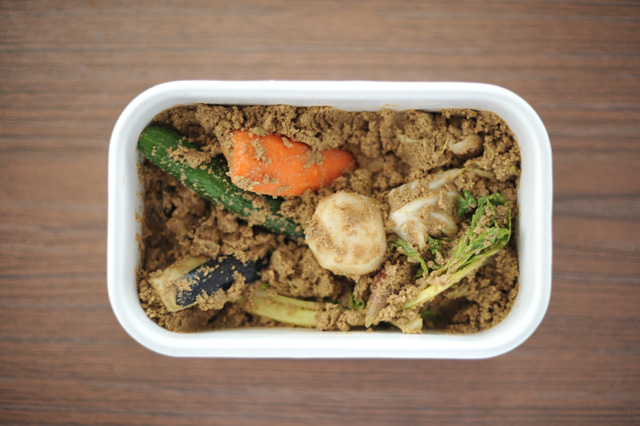
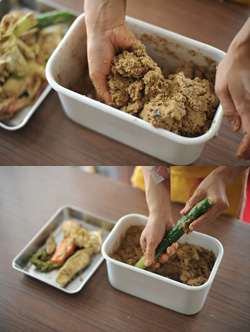
People have been taking notice of nukazuke pickles recently, as they have appeared in TV dramas and other media. Nukazuke has long been a part of Japan’s food culture that has been passed down in homes from generation to generation. Today, people are looking at nukazuke again, both for its deliciousness and for its hidden health benefits.
Shioyama Nao, a lifestyle and cooking expert who maintains her own nukadoko, explains. “Nukazuke are pickles made by pickling seasonal vegetables and other ingredients in a bed of fermented rice bran called a nukadoko. There are several theories about their origin, but it is generally agreed that nukazuke came about in the Edo period (1603 to 1868) when eating white rice became commonplace. It was a clever way to reuse the bran that was produced when brown rice was polished and it helped supplement the nutrients that people were lacking.”
Rice bran is rich in minerals, such as magnesium and iron, as well as vitamins such as B1 and B6. Through fermentation, the nukadoko becomes home to plenty of lactic acid bacteria and yeast that help to regulate the gut microbiome. Not only does pickling vegetables increase their umami and aroma, it also multiples the amount of vitamin B1 and other nutrients several times over compared to eating vegetables raw.
“I started making nukazuke in earnest about three years ago. As a result, I can eat a lot more seasonal vegetables and get a keen sense of their deliciousness. And especially after I had my child, I experienced firsthand how the combination of rice, miso soup, and nukazuke are really good for your body.”
Nukadoko have an image of being difficult to maintain. Shioyama explains that she wants to make it easier for people to integrate nukadoko into their lives.
“It’s interesting that the flavor the nukadoko produces changes depending on how you look after it. You just can’t abandon the nukadoko, but you shouldn’t fiddle with it too much either. I say that you should try a nukadoko without overthinking it, and should you fail, you can always make another one. Making a nukadoko is quite easy, and I should know because I’ve definitely messed up before.”
June is a good time to start making nukazuke, as the fermentation process progresses quickly and plenty of summer vegetables are available. The basic upkeep is to stir up the nukadoko from the bottom every day. During hot spells in the summer, it’s best to store your nukadoko in the vegetable compartment of your refrigerator.
“It’s fun raising your nukadoko, as you can add more bran whenever you want and put in additional ingredients to produce umami. I recommend pickling several types of vegetables together, as this gives the nukadoko more depth than if you just pickle one type of vegetable.”
Shioyama not only eats nukazuke raw; she also uses them in her cooking. Because it offers so many variations, making nukazuke becomes more worthwhile and you are less likely to get tired of eating them.
“Just altering how you slice them changes their texture and taste. Recently, I’ve gotten into cutting nukazuke into thin strips and using them in pork shabu-shabu salad. I also chop them up and use them in fried rice or soups or toss them with avocado. And it’s a good way to use up nukazuke that have been pickled for too long. The combination of cheese and nukazuke is amazing, probably because they are both fermented foods.”
Nukazuke harness the power of fermentation to deliciously transform seasonal vegetables. Why not try cultivating your own favorite flavors?
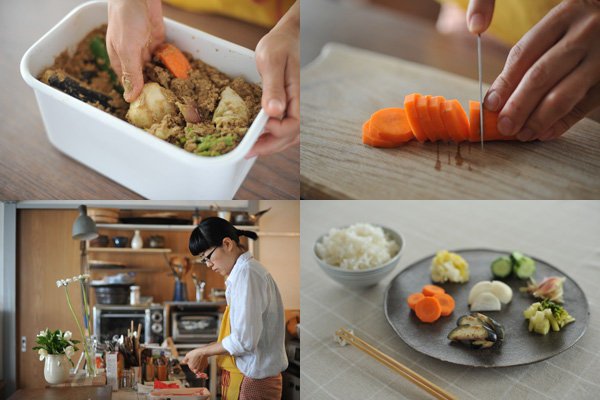
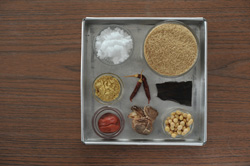
Ingredients
Rice bran…800 grams
Salt…120 grams
Water…650 mL
[Additional ingredients]
Powdered Japanese mustard…40 grams
Pickled ume plums…1 or 2
Red chili peppers… 2 or 3
Kelp…Five or six centimeters
Dried shiitake mushrooms…2 or 3
Dried soybeans…80 grams
Vegetable scraps…As available
Directions
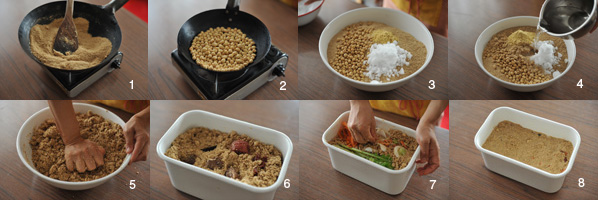
1.Roast the rice bran
Roast half of the rice bran in several batches over a low to medium heat in a frying pan or wok. Mix well to prevent the bran from scorching on the bottom of the pan. Turn off the heat when the bran becomes dry and fragrant. Use the remaining bran without roasting it.
2.Roast the soybeans
Roast the rinsed soybeans over a medium to high heat. Turn off the heat when you hear a popping sound and the surface of the beans is slightly browned.
3.Combine the ingredients
Put the rice bran, salt, powdered Japanese mustard, and soybeans in a large bowl or stock pot.
4.Add water
Add all the water in the ingredients list at once.
5.Mix together
Mix thoroughly from the bottom with your hands to make sure there are no lumps, and get the consistency so that it crumbles when squeezed. If it’s too hard, you can add a little water, but it should be on the firm side as moisture from the vegetables will come out later.
6.Add the remaining additional ingredients
Transfer the mixture to a storage container and add the dried shiitake mushrooms, kelp, picked ume plums, and deseeded chili peppers.
7.Add the vegetable scraps
Bury the vegetable scraps in the rice bran.
8.Leave at room temperature
Flatten the nukadoko and let it ferment at room temperature. Starting from the following day, stir up the nukadoko and replace the vegetable scraps every day or two when they have released all their moisture and have dried out. Taste the vegetable scraps and when they have taken on the flavor of nukazuke, the nukadoko is ready. It normally takes between one and two weeks.
Tips
・The additional ingredients act like a stock that adds umami and flavor to the nukadoko. You don’t have to add all of them, but the Japanese mustard and chili peppers are recommended because they have antibacterial and insect-repellent effects. You can add other things like sansho peppercorns, dried sardines, and dried bonito flakes.
・The vegetable scraps promote the activity of the lactic acid bacteria and are necessary for the nukadoko to ferment. In general, any scraps are fine, such as leftover bits of cabbage, carrot peels and stems, and apple or persimmon skins. However, you should avoid bitter or astringent scraps such as eggplant peels.
・Enamel or plastic storage containers are best for a nukadoko. Choose a container with plenty of room for maintaining the nukadoko.
・If a lot of moisture comes out from the vegetables, add more rice bran, dried shiitake mushrooms, or other additional ingredients that will absorb the moisture. If the taste becomes too sour, adding commercially available nukamiso mustard will mellow out the taste.
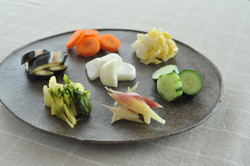
Ingredients and Directions
Cabbage…Separate the core from the leaves and pickle separately.
Pickling time: Three to six hours
Myoga ginger…Pickle without any particular preparation.
Pickling time: Three to six hours
Cucumber…Cut off the bitter stem end and pickle.
Pickling time: Three to six hours
Turnip…Peel if you prefer and rub with a little salt before pickling.
Pickling time: Six to nine hours
Celery…Remove the stringy fibers and cut into appropriate-sized pieces before pickling.
Pickling time: Six to nine hours
Carrot…Peel if you prefer and rub with a little salt. Cut lengthwise if large and then pickle.
Pickling time: Eight to 12 hours
Eggplant…Peel in places and rub with a little salt. Cut lengthwise if large and then pickle.
Pickling time: Eight to 12 hours
・The pickling times are only benchmarks. They will vary depending on the season.
・After taking the vegetables out from the nukadoko, wash off the bran and cut them into bite-sized pieces to eat.
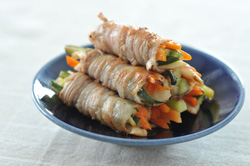
Ingredients (two-person serving)
Nukazuke (cucumbers, carrots, etc.)…As needed
Thinly sliced pork loin or boneless rib…Six to eight slices
Salt and pepper…As needed
Oil…As needed
Directions
1.Cut the nukazuke into thin strips about seven centimeters long.
2.Spread the meat slices out, sprinkle with salt and pepper, and roll them up with the nukazuke from Step 1 in the middle.
3.Heat the oil in a frying pan over a medium heat, and turn the roll-ups as they cook.

kurashiya
kurashiya
After working as a pattern maker, Shioyama became a self-proclaimed kurashiya [lifestyle expert], who provides suggestions for comfortable living through cooking and sewing. Her current activities involve books and magazines. She pens the “Daily Diligence” column in Chiruchin Bito (Fudosha). Her books include Getting Started with Fermented Food (Bungeishunji).